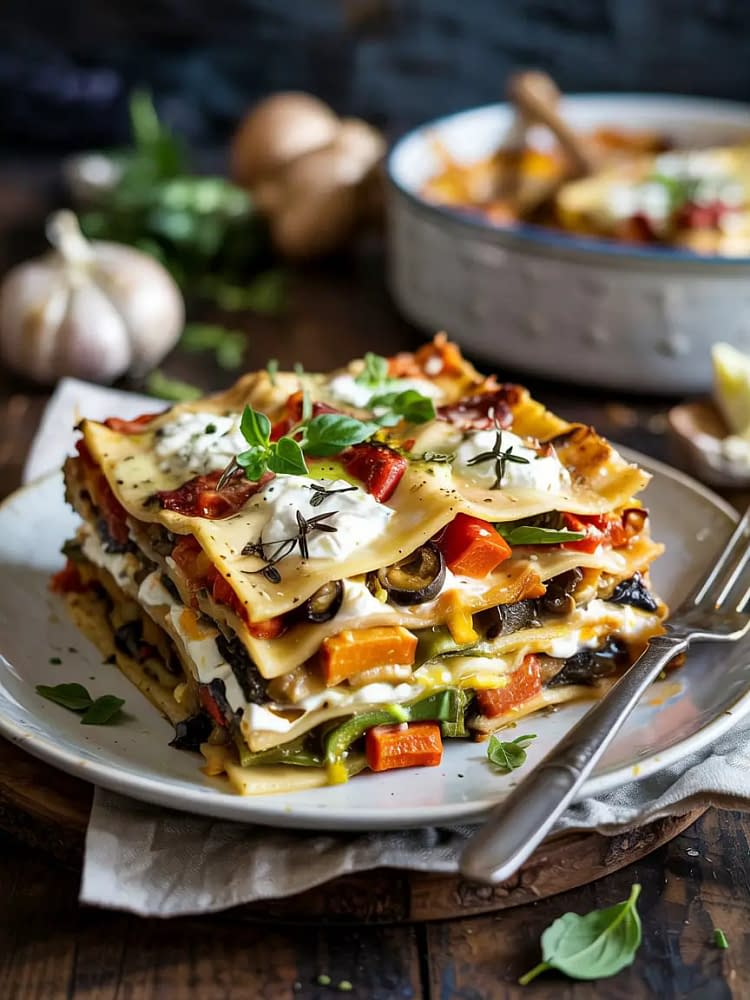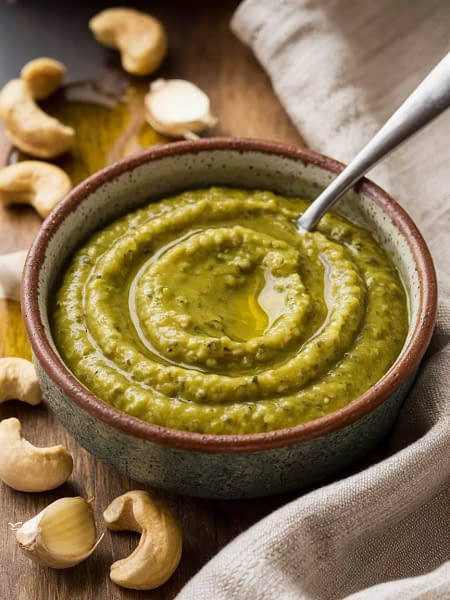Few dishes are as satisfying, aromatic, and visually appealing as a well-made layered Mediterranean vegetable lasagna with creamy ricotta. It blends the warmth and comfort of classic Italian lasagna with the vibrant, sun-kissed flavors of Mediterranean vegetables. Instead of heavy meats or rich sauces, this version leans into roasted eggplant, zucchini, peppers, onions, and delicate herbs that build depth with every layer. The result is a wholesome yet indulgent dish that feels fresh enough for summer but hearty enough for cold evenings.
This recipe is ideal for families, vegetable lovers, and anyone searching for a flavorful baked pasta dish that offers both nourishment and comfort. Because it relies on simple ingredients—fresh vegetables, ricotta, tomatoes, and lasagna sheets—it is accessible and budget-friendly, yet the end result tastes like something you’d find in a coastal Mediterranean café.
What Makes This Mediterranean Vegetable Lasagna Special
Mediterranean flavors are known for their brightness and simplicity, but when layered into a baked dish, they develop a deeper richness that creates the perfect balance. This lasagna stands out for several reasons.
A Focus on Seasonal Vegetables
Mediterranean cuisine emphasizes cooking with what’s available in each season. Here, eggplant, zucchini, peppers, and onions serve as the foundation. These vegetables roast beautifully and release their natural sweetness. They hold up well through baking while maintaining a pleasant texture.
A Creamy Ricotta Layer That Adds Depth
Ricotta brings a velvety creaminess to every bite. Combined with herbs, lemon zest, parmesan, and a touch of egg for structure, it creates a luxurious layer that lightens the earthy roasted vegetables.
A Tomato Herb Sauce That Ties It All Together
Even though the sauce is simple—just tomatoes, garlic, and herbs—it’s essential for bringing moisture, acidity, and cohesion to the lasagna. It helps the pasta sheets soften, balances the creaminess of the ricotta, and complements the caramelized vegetables.
A Lighter Alternative to Heavier Meaty Lasagnas
This layered Mediterranean vegetable lasagna with creamy ricotta satisfies in the same way as a traditional lasagna but avoids the heaviness of beef or sausage. It’s vegetarian, wholesome, and ideal for guests with diverse dietary preferences.
Ingredients Overview
This section provides more than just a list. Instead, it explains what each ingredient brings to the dish, ensuring that you understand why the recipe works so well and how each choice enhances the final flavor.
The Mediterranean Vegetable Base
Eggplant
Eggplant is essential for giving body and heartiness. Cutting it into cubes allows it to roast evenly and absorb just enough olive oil for a tender texture without becoming soggy.
Zucchini
Zucchini becomes beautifully soft when roasted and adds moisture to the lasagna. Thin slices or half-moons work best for balanced layering.
Bell Peppers
Red and yellow peppers provide sweetness and brightness. Their natural sugars caramelize in the oven, adding complexity to the lasagna.
Red Onion
Red onion roasts into a mild, slightly sweet component that blends seamlessly into the layers.
The Creamy Ricotta Filling
Ricotta Cheese
The star of the creamy layer. Choose whole-milk ricotta for the richest texture.
Parmesan
Adds saltiness, nuttiness, and a sharper flavor to balance the creaminess.
Egg
Helps bind the ricotta mixture so it doesn’t ooze out during slicing.
Lemon Zest
A small but transformative ingredient that introduces freshness.
Parsley
Bright, herbal, and classic in Italian-style fillings.
The Tomato Herb Sauce
Crushed Tomatoes
A smooth but thick base that coats the lasagna sheets well.
Garlic and Onion
These aromatics round out the sauce and bring depth.
Mediterranean Herbs
Oregano, thyme, and basil bring warmth and the signature aroma associated with tomato-based dishes.
Lasagna Sheets
Either oven-ready or pre-boiled noodles work. Oven-ready sheets save time and absorb moisture from the sauce and vegetables during baking.
Cheese for Topping
Mozzarella provides the stretchy, golden topping while parmesan melts into crisp, flavorful spots that make the top irresistible.
Step-by-Step Instructions for the Perfect Mediterranean Vegetable Lasagna
This section walks through each step of the recipe while also offering in-depth explanations and chef-level tips that can help you achieve the best texture, flavor, and presentation.
Preparing the Vegetables
Cutting the Vegetables Evenly
Uniform pieces ensure even roasting. For eggplant, 1-centimeter cubes are ideal. Zucchini can be sliced into thin rounds or half-moons. Bell peppers should be sliced into long strips that soften well.
The goal is to create vegetables that will cook at the same rate and layer neatly.
Removing Bitterness from Eggplant
Lightly salting eggplant before roasting draws out excess moisture and reduces bitterness. Let the cubes sit for 10–15 minutes, then pat dry with a paper towel.
Seasoning for Depth
Olive oil blends beautifully with oregano, basil, smoked paprika, salt, and pepper. This combination echoes Mediterranean flavors and enhances natural sweetness during roasting.
Roasting for Perfect Texture
Roasting at 190°C encourages caramelization without burning. A high enough temperature ensures the vegetables soften while developing golden edges that make the final lasagna more flavorful and textured.
Preparing the Tomato Herb Sauce
Building Aromatic Layers
Start by gently sautéing garlic and onions until soft and fragrant. This creates a base that enhances the acidity of tomatoes and adds complexity.
Simmering for Balance
Letting the crushed tomatoes simmer helps them reduce slightly, concentrating their flavor.
The herbs absorb into the sauce, creating a unified blend that complements the vegetables and ricotta.
Why a Light Sauce Works Best
Unlike meat lasagna, which needs a thick and hearty sauce, this Mediterranean vegetable lasagna benefits from a lighter, smoother sauce that doesn’t overpower the delicate flavors of the vegetables.
Making the Creamy Ricotta Filling
Achieving the Right Consistency
Mix the ricotta with parmesan, an egg, lemon zest, parsley, salt, and pepper.
The mixture should be spreadable but firm enough to hold its shape.
Balancing Creaminess and Freshness
The combination of parmesan and lemon zest adds brightness and prevents the ricotta from feeling too heavy.
Assembling the Lasagna
Preparing the Baking Dish
Spread a thin layer of tomato sauce at the bottom. This prevents sticking and gives a moist base for the lasagna sheets.
Layering Strategy
The ideal layering sequence is:
- Lasagna sheets
- Ricotta mixture
- Roasted vegetables
- Tomato sauce
- Shredded mozzarella
Repeat until all ingredients are used, finishing with sauce, mozzarella, and a sprinkle of parmesan.
Why Layering Matters
Each layer contributes texture and flavor. Spreading ingredients evenly ensures every bite tastes well balanced. Since vegetables contain water, alternating them with cheese and pasta sheets helps maintain structure and avoids sogginess.
Baking and Resting
Covered Baking Phase
Covering the dish with foil for the first 25 minutes traps steam, helping the pasta soften and the lasagna cook evenly.
Uncovered Browning Phase
Removing the foil allows the cheese to brown, bubble, and develop that golden top everyone loves.
The Importance of Resting
Resting for at least 10 minutes is essential.
It allows the lasagna to firm up so it slices cleanly and prevents the cheese and sauce from spilling out.
Tips for the Best Mediterranean Vegetable Lasagna
Roast Instead of Sauté
Roasting intensifies flavor without making vegetables watery. This prevents the lasagna from becoming mushy.
Avoid Over-Saucing
Too much sauce can cause the lasagna to collapse. A light coating works perfectly for this recipe.
Choose Quality Ricotta
Low-moisture, whole-milk ricotta produces the creamiest results and won’t separate while baking.
Use a Sharp Knife for Slicing
A long, thin chef’s knife or serrated knife cuts through layers cleanly, keeping the portions intact.
Let Leftovers Rest Overnight
Like many baked pasta dishes, this layered Mediterranean vegetable lasagna with creamy ricotta tastes even better the next day.
Variations You Can Try
Adding Spinach or Kale
A layer of sautéed spinach or tender kale adds nutrients and blends well with the ricotta mixture.
Using Different Cheeses
Feta or halloumi can give the lasagna a more intense Mediterranean profile, though they should be added sparingly to avoid overpowering the dish.
Gluten-Free Version
Use gluten-free pasta sheets and check that your ricotta and parmesan are certified gluten-free.
Vegan Version
Replace ricotta with cashew-based ricotta, mozzarella with vegan cheese, and skip the egg.
Roast vegetables with extra olive oil to enhance richness.
Spicy Variation
Add more chili flakes into the sauce or roasted vegetables for a warm, peppery undertone.
Serving Suggestions
Ideal Side Dishes
This lasagna pairs beautifully with:
• A crisp arugula and tomato salad
• Olive oil–brushed garlic bread
• A side of marinated olives
• Roasted asparagus or green beans
Garnishes That Elevate the Dish
Fresh basil leaves, a sprinkle of parmesan, or a drizzle of high-quality olive oil add fragrance and visual appeal right before serving.
When to Serve
This dish works for:
• Weeknight dinners
• Weekend gatherings
• Potlucks
• Meal prep for busy weeks
Its versatility and balanced flavors make it an excellent centerpiece for seasonal events throughout the year.
Storage and Make-Ahead Instructions
Refrigeration
Store in an airtight container for 3–4 days. The flavor continues to develop over time.
Freezer Instructions
You can freeze it baked or unbaked.
Unbaked lasagna freezes exceptionally well and can be baked directly from frozen with slightly longer cooking time.
Reheating
Reheat in the oven at 180°C for best results.
Microwave reheating works but may soften the layers more than ideal.
Final Thoughts
A layered Mediterranean vegetable lasagna with creamy ricotta offers a beautiful balance of comfort and freshness. It’s a recipe that feels familiar yet exciting, hearty yet wholesome, and simple yet elevated. Whether you’re preparing it for family dinner, as a make-ahead meal, or to share at a gathering, this lasagna brings warmth and satisfaction to the table
Layered Mediterranean Vegetable Lasagna with Creamy Ricotta Recipe
This Layered Mediterranean Vegetable Lasagna with Creamy Ricotta is a hearty, flavor-packed, and comforting dish that brings together roasted vegetables, silky ricotta, and perfectly baked lasagna sheets. It’s wholesome, rich, and ideal for everyday dinners or special gatherings. With layers of tender veggies, aromatic herbs, and a creamy ricotta blend, this Mediterranean-inspired lasagna delivers both nutrition and indulgence in every bite.
Ingredients
For the Roasted Mediterranean Vegetables
For the Tomato Herb Sauce
For the Creamy Ricotta Layer
For Assembly
Instructions
Roast the Mediterranean Vegetables
- Spread the cubed eggplant, zucchini slices, bell peppers, and red onion wedges on a large baking tray. Drizzle with olive oil, sprinkle oregano, basil, smoked paprika, salt, and pepper. Toss well to coat evenly. Roast at 190°C for 20–25 minutes until softened and slightly caramelized. Set aside.
Prepare the Tomato Herb Sauce
- Heat olive oil in a medium saucepan over medium heat. Add garlic and onion, sauté until soft and fragrant. Stir in crushed tomatoes, oregano, thyme, red chili flakes (if using), salt, and pepper. Let the sauce simmer for 10–12 minutes until slightly thickened and flavorful.
Mix the Creamy Ricotta Layer
- In a bowl, combine ricotta, parmesan, egg, lemon zest, parsley, black pepper, and a pinch of salt. Mix until smooth and evenly blended. This will be your rich, creamy layer for the lasagna.
Prepare the Baking Dish
- Lightly oil a 9×13-inch baking dish. Spread a thin layer of tomato herb sauce at the bottom to prevent sticking.
Start Layering the Lasagna
- Place your first layer of lasagna sheets over the sauce. Add a generous layer of the ricotta mixture, spreading it evenly. Add a layer of roasted vegetables. Spoon a layer of tomato sauce on top. Sprinkle a handful of mozzarella.
Continue Layering
- Repeat the layering process—pasta, ricotta, vegetables, sauce, mozzarella—until all ingredients are used. Finish the final top with tomato sauce, mozzarella, and a sprinkle of parmesan for a golden, cheesy crust.
Bake the Lasagna
- Cover the dish with foil and bake at 190°C for 25 minutes. Remove foil and continue baking another 20–25 minutes until the top is bubbly and golden brown.
Rest & Serve
- Allow the lasagna to rest for at least 10 minutes before slicing. Garnish with fresh basil leaves and serve warm.
Note
Make it vegan: Replace ricotta with cashew ricotta, mozzarella with vegan cheese, and omit the egg.
Gluten-free option: Use gluten-free lasagna sheets.
Storage: Keeps 3–4 days in the refrigerator. Reheat gently at 180°C.
Freezing: Freeze the unbaked lasagna for up to 2 months; bake directly from frozen at 180°C for extra time.
Add-ins: Sautéed mushrooms or spinach make great additions.








